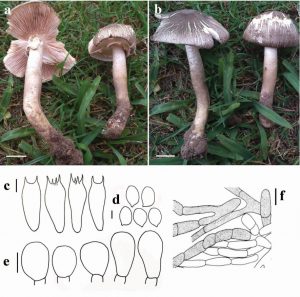Agaricus punjabensis T. Qasim, A. Ashraf & A.N. Khalid, sp. nov., Index Fungorum Number: IF 814981
Etymology: Refers to the Punjab, the region where the holotype of the species was collected.
Diagnosis: This species is characterized by a dark, greyish brown, fibrillose pileus, more or less concolorous or slightly paler stipe, spores with an average size of 4.5 × 3.2 μm, small-sized cheilocystidia and pileipellis elements containing brownish, diffuse pigment.
Pileus 5–6.6 cm, hemispherical when young, becoming plano-convex at maturity, slightly umbonate; surface dry, uniformly covered with innate, dark greyish brown appressed fibrils, becoming radially fibrillose, splitting radially upon expansion or partially cracking into small, appressed, dark brownish grey scales on a white background. Margin entire, and often appendiculate with veil remnants from the annulus, fissile at maturity. Lamellae free and crowded, moderately thick, broad, with intercalated lamellulae, pinkish, becoming dark brown with age. Stipe 7–8.6 cm, cylindrical, surface smooth, dark greyish brown at the base, light brown up to the annulus, white above the annulus. Annulus superior, membranous, double, upper side smooth, lower side with scales arranged into a cogwheel, the tip of each cog showing a linear, arc-shaped scale concolorous with the pileus. Odour not recorded. Context thick, fleshy, discolouration by cutting not recorded.
Basidiospores (3.5–)4.2–4.7(–5) × (2.5–)2.6–3(–3.5) μm, [x̄= 4.5 × 3.2 μm, Q = 1.4–1.43, Qm = 1.41, n = 60], ellipsoid, smooth, dark brown, thick-walled, apiculus present. Basidia (11.8–)13–17.7(–18.8) × (4.5–)4.9–6.1(–6.8) μm, hyaline, thin walled, smooth, 4-spored, rarely 2-spored. Cheilocystidia (9–)10.6–11.3(–11.8) × (4–)4.5–6.2(–7) μm, hyaline, moderately thin walled, smooth, sub-clavate to sphaeropedunculate. Pleurocystidia absent. Pileipellis a cutis composed of hyphae, 6–17 μm wide, containing brown diffused pigment, smooth, branched.
Habitat: Saprotrophic, solitary or in pairs, on nutrient-rich loamy soil under planted angiosperm vegetation.
Type: PAKISTAN. Punjab, University of the Punjab, Lahore, alt. 217 m, 20 September 2014, collectors T. Qasim & A.N. Khalid A4 (holotype, LAH 10192014!).
Additional specimens examined: PAKISTAN. Punjab, University of the Punjab, Lahore, alt. 217 m, 20 September 2014, collectors A.N. Khalid & T. Qasim, A5 (LAH 10202014!).
Notes: Agaricus endoxanthus is highly similar to A. punjabensis by having a dark coloured pileus, fibrillose or radially cracked, and brownish coloured stipe base. However, A. endoxanthus differs by its larger basidiospores (5.2 × 3.3 μm on average), larger cheilocystidia (14–26 × 10–17 μm), and pileipellis hyphae containing both diffused and vacuolar pigments (Parra 2013). According to the phylogenetic analyses, A. punjabensis formed a well-supported subclade with A. endoxanthus and A. xanthosarcus in the clade Xan III of section Xanthodermatei. The new species differs at 11 positions from A. xanthosarcus and at eight positions from A. endoxanthus. Among the whole section Xanthodermatei, A. punjabensis possesses two species-specific characters, one insertion tcct[A]gtca @ 208 and one substitution agctCctaa @ 623.
Several other members of section Xanthodermatei show a dark greyish pileus, but they can be easily distinguished from A. punjabensis by the following characters: A. moelleri differs in its white stipe surface both above and below the annulus, larger basidiospores (5.8 × 3.7 μm on average) and larger clavate, pyriform, globose or sphaeropedunculate cheilocystidia (10–28 × 7–20 μm; Parra 2013); A. moelleroides Guinb. & L.A. Parra (2013: 109) which is highly similar to A. moelleri but different in its white stipe surface both above and below the annulus, larger basidiospores (5.57 × 3.47 μm on average) and larger cheilocystidia (10–28 × 8–17 μm); A. volvatulus and A. microvolvatulus Heinem. (1971: 6) both have a distinctly marginate bulbous stipe base (Heinemann 1956; Thongklang et al. 2014);
A. xanthosarcus differs in its larger, brownish cheilocystidia (21–35 × 12–19 μm), and pileipellis hyphae containing
vacuolar pigment (Heinemann 1956).

Fig. 1. Agaricus punjabensis (holotype). a–b. Sporocarps in situ. c. Basidia. d. Basidiospores. e. Cheilocystidia. f. Pileipellis. Scale bars: a–b = 1 cm; c, e = 5 μm; d = 2 μm; f = 20 μm.
